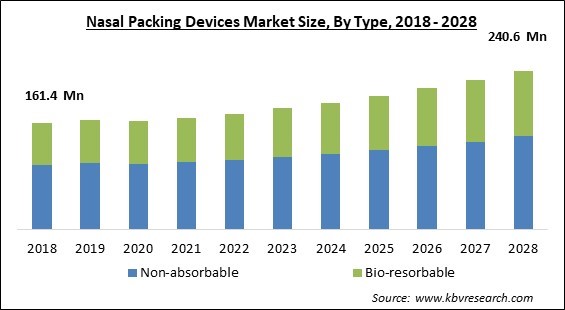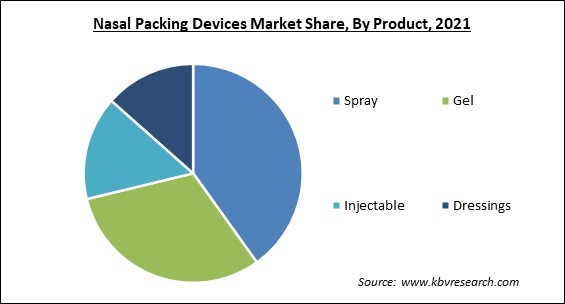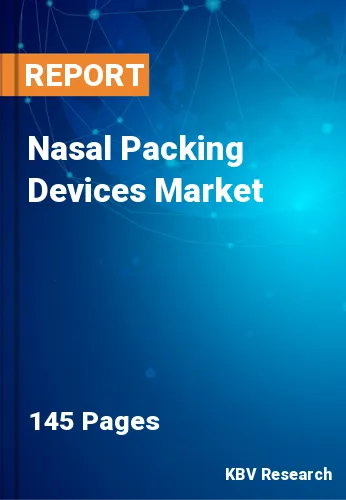The Global Nasal Packing Devices Market size is expected to reach $240.6 million by 2028, rising at a market growth of 5.4% CAGR during the forecast period.
Nasal packing devices are intranasal devices that apply constant local compression to the nasal septum and are used to treat epistaxis (nosebleed). Epistaxis is caused by a tiny blood artery in the nose lining fracturing. The inside of the nose is fragile as well as highly sensitive to certain conditions, making it vulnerable to bursting and bleeding. There are two types of epistaxis viz. anterior and posterior, each of which necessitates a distinct nasal packing device. For failure of anterior packing, accurate or high suspicion of posterior bleeding, and patients with bleeding diathesis, such as antiplatelet medication, von Willebrand disease (vWD), anticoagulation, and hemophilia, posterior nasal packing is recommended.

If the otorhinolaryngologist is unable to determine the source of the bleeding, if the bleeding is from multiple sources, if there is no specialized equipment or expertise in endoscopic management available, or if the patient cannot endure extensive bedside nasal manipulation, nasal packing may be recommended as a temporary or permanent solution. Lower socioeconomic status, the region within the South or Midwest, non-trauma hospital condition, long-term anticoagulation, male gender, older age, and the winter season were identified as risk factors associated with the use of nasal packing in several research studies.
In most cases, the first step is to implant an anterior nasal packing. These are often placed into the nasal cavity using bayonet forceps or manually with a nasal speculum to dilate the nares and can be either absorbable or nonabsorbable. It's crucial to aim the nasal pack inferiorly, rather than superiorly, toward the middle turbinate and the base of the skull. Synthetic polyurethane foam and hyaluronic acid are two commonly utilized absorbable packing materials.
The COVID-19 pandemic caused a severe downfall to businesses all over the world. The pandemic caused a major impact on the healthcare industries of various countries all over the world. Healthcare experts, hospitals, personnel, and patients were compelled to follow the contamination policy to prevent the infection from spreading. During the COVID-19 pandemic, there was a considerable increase in patient visits for epistaxis. Epistaxis may show as a presenting symptom of COVID-19. In addition, a significant number of patients with epistaxis during the pandemic tested positive for COVID-19. However, during the COVID-19 pandemic, the use of nasal packing devices increased. During the pandemic, the virus's spread posed a persistent threat to healthcare workers and patients.
The pollution level in various countries across the world is continuously increasing. The air people are inhaling is increasingly becoming hazardous for them. With a reduction in the quality of air, certain other problems occur that are needed to be addressed immediately. However, due to the lack of efforts of people and governments all over the world, these problems are rapidly increasing. One of the most common factors that are increasing the incidence of nosebleeds is the dry air, which can be linked with the constantly declining air quality all over the world. Hot, low-humidity climates, as well as warm interior air, can contribute to dry air. Both settings lead the nasal membrane, the fragile tissue inside the nose, to dry out and become crusty or cracked, making it more likely to bleed when rubbed, plucked, or blown. Smog, hazy clouds of stagnant air with ozone gas particles that float above metropolitan centers, can be seen with naked eyes throughout the year over extremely polluted cities.
Bacteria and viruses that cause ear, nose, and throat infections are frequently the same. However, based on where the infection is located, the symptoms may vary. Ear infections can result in earaches, wax or discharge, hearing loss, balance issues, and especially, nosebleed among other problems. A runny or blocked nose, as well as sneezing, is common symptoms of nose infections, which, if at a severe stage, can compel the nose to bleed out. Infections that spread to the sinuses can cause a variety of symptoms, including headaches. A sore or itchy throat, as well as pain or trouble swallowing, are all symptoms of a throat infection. Swollen glands in the neck may also be noticeable. All three types of infections can induce more general illness symptoms, such as fever and nasal infections, and can easily travel among the ears, nose, and throat of the patient.

While the packing is being done, the patient may feel as though they have a regular cold. The patient may experience a stuffy nose, a loss of smell, pressure around their face, headaches, a runny nose, and eye tears. In addition, they would not be able to breathe through the packed nostril because the nasal pack has filled the opening. However, this is temporary, it can cause significant inconvenience and irritation to the patient. Nasal packing is frequently painful for the patient during its placement, removal, as well as presence. Further, nasal packing must be used for at least 24 hours, with at least 48 hours required for higher-risk patients. Treatment failures have been linked to shorter packing periods.
Based on Product, the market is segmented into Spray, Gel, Injectable, and Dressings. In 2021, the gel segment garnered a significant revenue share of the nasal packing devices market. The constantly rising growth of the segment is owing to the ease of use of gel packing. Moreover, the segment is also anticipated to grow due to recent developments with excellent efficacy of gel manufacturing. The utilization of these products is also rising due to the increasing patient comfort as well as hemostatic qualities. The most effective and common products for treating nosebleeds are gel and dressings.
Based on Type, the market is segmented into Non-absorbable and Bio-resorbable. In 2021, the non-absorbable segment procured the highest revenue share of the nasal packing devices market. The increasing growth of the segment is attributed to the significant prevalence of this approach across various healthcare facilities all over the world. The non-absorbable nasal packing devices are already well-established and preferred by doctors and other healthcare specialists. Moreover, this type of nasal packing is also less expensive than bio-resorbable nasal packing devices. This is one of the major factors that is driving the growth of this segment.
| Report Attribute | Details |
|---|---|
| Market size value in 2021 | USD 168.8 Million |
| Market size forecast in 2028 | USD 240.6 Million |
| Base Year | 2021 |
| Historical Period | 2018 to 2020 |
| Forecast Period | 2022 to 2028 |
| Revenue Growth Rate | CAGR of 5.4% from 2022 to 2028 |
| Number of Pages | 151 |
| Number of Tables | 260 |
| Report coverage | Market Trends, Revenue Estimation and Forecast, Segmentation Analysis, Regional and Country Breakdown, Companies Strategic Developments, Company Profiling |
| Segments covered | Product, Type, Region |
| Country scope | US, Canada, Mexico, Germany, UK, France, Russia, Spain, Italy, China, Japan, India, South Korea, Singapore, Malaysia, Brazil, Argentina, UAE, Saudi Arabia, South Africa, Nigeria |
| Growth Drivers |
|
| Restraints |
|
Based on Regions, the market is segmented into North America, Europe, Asia Pacific, and Latin America, Middle East & Africa. In 2021, Asia-Pacific accounted for the largest revenue share of the nasal packing devices market. The rise in the number of nasal packing device manufacturers, significant unmet demands, expanding economy, and overall increasing healthcare infrastructure, especially in developing nations like China and India, are all factors contributing to this growth of this segment. Furthermore, the market is growing due to increased awareness of nasal packing devices and their applications.
Free Valuable Insights: Global Nasal Packing Devices Market size to reach USD 240.6 Million by 2028
The market research report covers the analysis of key stake holders of the market. Key companies profiled in the report include Smith & Nephew PLC, Medtronic PLC, Stryker Corporation, Olympus Corporation, Summit Health, Network Medical Products Ltd., Lohmann & Rauscher GmbH & Co. KG, Meril Life Science Private Limited, First Aid Bandage Company, and Aegis Lifesciences Pvt. Ltd.
By Product
By Type
By Geography
The nasal packing devices market size is projected to reach USD 240.6 million by 2028.
Declining air quality all over the world are driving the market in coming years, however, Discomfort and risks related with nasal packing limited the growth of the market.
Smith & Nephew PLC, Medtronic PLC, Stryker Corporation, Olympus Corporation, Summit Health, Network Medical Products Ltd., Lohmann & Rauscher GmbH & Co. KG, Meril Life Science Private Limited, First Aid Bandage Company, and Aegis Lifesciences Pvt. Ltd.
The expected CAGR of the nasal packing devices market is 5.4% from 2022 to 2028.
The Spray segment acquired maximum revenue share in the Global Nasal Packing Devices Market by Product in 2021, thereby, achieving a market value of $89.4 Million by 2028.
The North America market dominated the Global Nasal Packing Devices Market by Region in 2021, and would continue to be a dominant market till 2028; thereby, achieving a market value of $91.2 Million by 2028.
Our team of dedicated experts can provide you with attractive expansion opportunities for your business.

